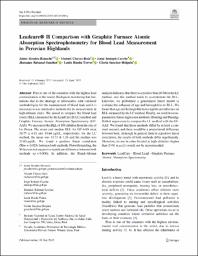Leadcare II Comparison with Graphite Furnace AtomicAbsorption Spectrophotometry for Blood Lead Measurementin Peruvian Highlands

View/
Download
(application/pdf: 2.782Mb)
(application/pdf: 2.782Mb)
Date
2022-05-22Author(s)
Rosales-Rimach, Jaime
Chavez-Ruiz, Manuel
Inolopú-Cucche, Jorge
Rabanal-Sanchez, Jhonatan
Rueda-Torres, Lenin
Sanchez-Holguin, Gloria S
Metadata
Show full item recordAbstract
Peru is one of the countries with the highest leadcontamination in the world. Biological monitoring has lim-itations due to the shortage of laboratories with validatedmethodologies for the measurement of blood lead, and it isnecessary to use alternative methods for its measurement inhigh-altitude cities. We aimed to compare the blood leadlevels (BLL) measured by the LeadCare II (LC) method andGraphite Furnace Atomic Absorption Spectrometry (GF-AAS). We measured the BLL of 108 children from the city ofLa Oroya. The mean and median BLL for GF-AAS were10.77±4.18 and 10.44lg/dL, respectively; for the LCmethod, the mean was 11.71±4.28 and the median was11.60lg/dL. We found a positive linear correlation(Rho = 0.923) between both methods. Notwithstanding, theWilcoxon test suggests a significant difference between bothmethods (q= 0.000). In addition, the Bland–Altmananalysis indicates that there is a positive bias (0.94) in the LCmethod, and this method tends to overestimate the BLL.Likewise, we performed a generalized linear model toevaluate the influence of age and hemoglobin on BLL. Wefound that age and hemoglobin had a significant influence onBLL measured by the LC method. Finally, we used two non-parametric linear regression methods (Deming and Passing-Bablok regression) to compare the LC method with the GF-AAS. We found that these methods differ by at least a con-stant amount, and there would be a proportional differencebetween both. Although in general there is a positive linearcorrelation, the results of both methods differ significantly.Therefore, its use in cities located at high altitudes (higherthan 2440 m.a.s.l.) would not be recommended.
Collections
- SCOPUS [380]

